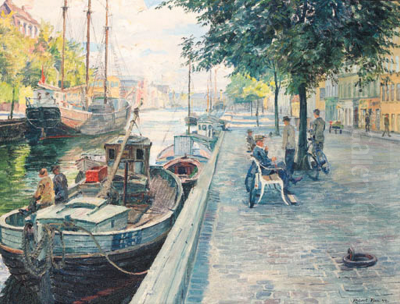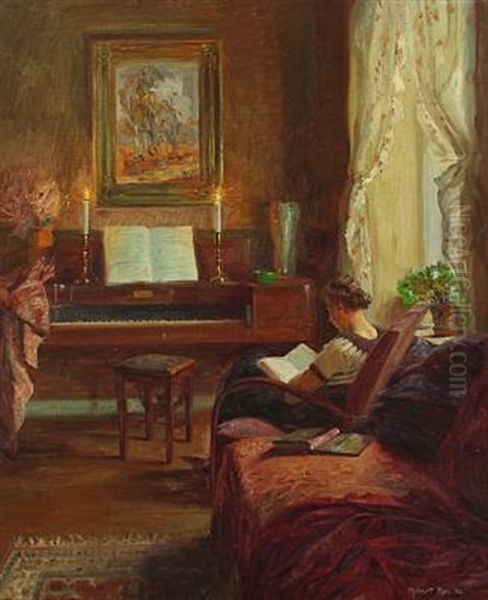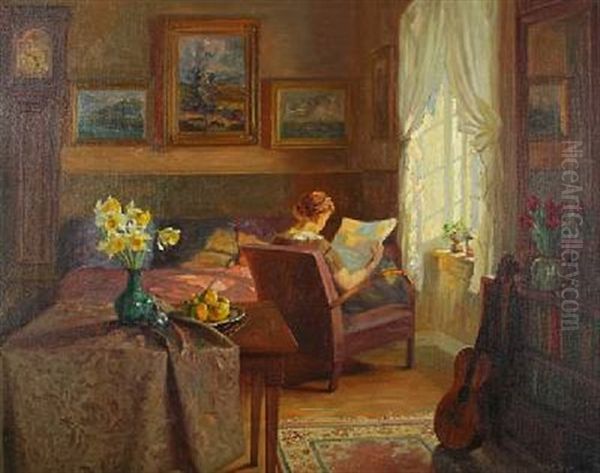
Robert Panitzsch stands as a notable figure in Danish art history, recognized primarily for his sensitive and atmospheric depictions of domestic interiors, often illuminated by natural light and inhabited by solitary female figures. Active during the late 19th and first half of the 20th century, his work offers a window into the quiet elegance and contemplative moods of bourgeois life in Denmark during his era. While perhaps not as internationally renowned as some of his contemporaries, Panitzsch carved a distinct niche with his consistent focus on light, space, and the tranquil moments of everyday existence.
Origins and Danish Identity
Robert Panitzsch was born in 1879. Although he would become known as a Danish painter, his origins lie in Mecklenburg, Germany. Like many artists and individuals throughout history, migration played a role in shaping his identity and career. He later moved to Denmark, embraced the country as his home, and eventually became a Danish citizen. This transition is significant, placing his artistic output firmly within the context of Danish art, even with his German roots.
His life spanned a period of significant change in Europe, from the late Victorian era through two World Wars, ending in 1949. While historical records confirm his lifespan (1879-1949) and his profession as a painter, detailed information about his personal life, his specific motivations for moving to Denmark, or extensive biographical anecdotes remain relatively scarce in easily accessible sources. His legacy, therefore, is primarily understood through the body of work he left behind.
The Essence of Panitzsch's Style: Light and Atmosphere
The defining characteristic of Robert Panitzsch's art is his masterful handling of light, particularly natural light entering interior spaces. His paintings often feature rooms bathed in the soft glow of sunlight streaming through windows, casting gentle shadows and highlighting the textures of fabrics, furniture, and polished surfaces. This focus on light is not merely descriptive; it is fundamental to the mood and composition of his works.

Panitzsch used light to create a sense of warmth, intimacy, and tranquility. Unlike the Impressionists, such as Claude Monet or Camille Pissarro, who often used broken brushwork to capture the fleeting effects of light outdoors, Panitzsch employed a more controlled, realistic technique suited to the stillness of interiors. His light feels palpable yet gentle, defining forms and creating a serene, almost timeless atmosphere within the depicted rooms.
The interplay between light and shadow is carefully orchestrated, drawing the viewer's eye towards specific points of interest – often a figure engaged in a quiet activity or a particularly well-lit piece of furniture. This skillful manipulation of chiaroscuro contributes significantly to the peaceful and contemplative quality that permeates his oeuvre. His approach resonates with a long tradition of interior painting where light itself becomes a subject, echoing, in spirit if not style, masters like Johannes Vermeer.
Subject Matter: Interiors and Solitude
Panitzsch's preferred subject was the domestic interior. He depicted comfortable, well-appointed rooms that suggest a middle-class or upper-middle-class milieu. These spaces are rendered with considerable attention to detail, showcasing furniture, decorative objects, paintings on the walls, and textiles. His compositions often emphasize the structure of the room, using doorways, windows, and furniture arrangements to create a sense of depth and spatial harmony.
A recurring motif in his work is the solitary female figure, typically engaged in quiet pursuits such as reading, sewing, or simply resting in contemplation. These figures are rarely depicted with strong emotion or dramatic gestures; instead, they embody the peacefulness and introspection of the spaces they inhabit. The woman reading, in particular, is a frequent subject, suggesting themes of quiet intellectualism, escapism, or simply the comfort of domestic solitude.
His focus on intimate interior scenes places him in dialogue with other artists known for similar themes. In Denmark, his work can be seen as continuing, in some ways, the legacy of the Danish Golden Age painters like Christen Købke, who also excelled at depicting domestic life, albeit in an earlier period. More closely contemporary, Carl Holsøe and, perhaps most famously, Vilhelm Hammershøi, were also masters of the Danish interior, though Hammershøi's work often carries a more pronounced sense of melancholy, mystery, and spatial austerity compared to Panitzsch's generally warmer scenes.
Connection to Decorative Arts

An interesting aspect of Panitzsch's career, mentioned in available sources, is his connection to the Museum of Decorative Art (Kunstindustrimuseet, now Designmuseum Danmark) in Copenhagen. It is noted that he worked there and incorporated antiques and Renaissance-period furniture from the museum's collection into his paintings. This practice adds another layer to his work, suggesting a deep appreciation for historical craftsmanship and design.
By including these specific, potentially recognizable objects, Panitzsch wasn't just creating generic scenes; he was grounding his interiors in a tangible reality enriched by historical artifacts. This integration of museum pieces into his painted domestic settings blurs the line slightly between a contemporary scene and a subtle homage to past artistic traditions. It highlights his eye for detail and his interest in the material culture that furnishes the lives of his subjects.
This connection also underscores the importance of decorative elements within his compositions. The furniture, textiles, and objects are not mere props; they are integral parts of the overall aesthetic, contributing to the mood and character of the space. His careful rendering of these items reflects a respect for their form and history, aligning with the sensibilities one might expect from someone associated with a museum of decorative arts.
Representative Works: A Closer Look
Several works are frequently cited as representative of Robert Panitzsch's style. Sunlit Interior with a Reading Woman (1945) exemplifies his core strengths. The painting typically showcases a room illuminated by strong sunlight, often creating distinct patterns on the floor or walls. A woman, absorbed in her reading, provides a focal point of quiet human presence amidst the carefully arranged furniture and the play of light. The atmosphere is one of undisturbed peace.
Similarly, Woman Reading in an Armchair (1936) explores this favoured theme. The composition might vary, perhaps focusing more closely on the figure or offering a different angle on the room, but the essential elements – the comfortable interior, the solitary woman, the importance of light, and the overall sense of tranquility – remain consistent. These works highlight his ability to capture a specific, gentle mood through the harmonious arrangement of space, light, and figure.
Another mentioned title, Woman Reading by the Window, further emphasizes the significance of the window as both a light source and a compositional element, framing the connection between the intimate interior world and the unseen exterior. The repetition of these themes across different works suggests a deliberate and sustained exploration of the quiet beauty found in everyday domestic life.
Panitzsch in the Context of Danish Art
Robert Panitzsch worked during a period that followed the celebrated Danish Golden Age (roughly the first half of the 19th century). While the Golden Age, with artists like Christen Købke, Constantin Hansen, and Wilhelm Bendz, had established a strong tradition of realism, portraiture, and landscape painting, the later 19th and early 20th centuries saw Danish art diversify.
The Skagen Painters, including P.S. Krøyer, Anna Ancher, and Michael Ancher, brought a vibrant, often Impressionist-influenced style to their depictions of fishermen and coastal life in northern Jutland. Their focus on plein air painting and communal life contrasts sharply with Panitzsch's intimate, interior focus. Another significant figure, Theodor Philipsen, was instrumental in bringing French Impressionism's influence to Denmark, particularly in landscape painting.
Panitzsch, along with artists like Vilhelm Hammershøi and Carl Holsøe, represented a different, quieter strand within Danish art – one focused on the subtleties of interior spaces and moods. While Hammershøi achieved greater international fame for his unique, often enigmatic and desaturated interiors, Panitzsch offered a warmer, perhaps more accessible vision of domestic tranquility. He maintained a commitment to representational painting even as Modernist movements began to emerge elsewhere in Europe.
Broader European Artistic Context
During Panitzsch's active years (roughly 1900-1949), European art was undergoing radical transformations. Post-Impressionism had already paved the way for Fauvism, Cubism, Expressionism, and Surrealism. Artists like Henri Matisse, Pablo Picasso, Wassily Kandinsky, and Salvador Dalí were challenging traditional notions of representation, colour, and form.
Panitzsch's work seems largely untouched by these avant-garde movements. His style remained rooted in a form of gentle realism, focused on traditional painterly concerns of light, form, and composition within a recognizable domestic setting. His artistic path aligns more closely with painters who continued to explore intimate themes and representational styles.
In France, the Intimists, such as Pierre Bonnard and Edouard Vuillard, also focused on domestic interiors, though often with a greater emphasis on pattern, flattened perspectives, and subjective colour, reflecting Post-Impressionist influences. In Britain, Walter Sickert depicted interiors, sometimes with a more somber or psychologically charged atmosphere. Panitzsch's work, while sharing the interior subject matter, maintained its distinct character – less decorative than Bonnard, less psychologically intense than Sickert, and less austere than Hammershøi.
Themes of Stillness and Introspection
The recurring elements in Panitzsch's paintings – the quiet rooms, the solitary figures, the gentle light – coalesce around themes of stillness, peace, and introspection. His work invites the viewer into a world removed from the hustle and bustle of modern life. The home is presented as a sanctuary, a place for quiet contemplation, reading, and personal reflection.
The frequent depiction of women reading is particularly significant. This motif has a long history in art, often symbolizing education, independence, or imaginative escape. In Panitzsch's context, it contributes to the overall atmosphere of quiet intellectualism and self-contained serenity. The figures seem content in their solitude, absorbed in their inner worlds or the pages of a book.
Light, too, functions thematically. It represents not just illumination but perhaps also clarity, comfort, and the gentle passage of time. The way light falls across a room, touching objects and figures, creates moments of quiet beauty, encouraging the viewer to pause and appreciate the simple elegance of the scene. Panitzsch seems to celebrate these uneventful, peaceful moments, finding profound beauty in the ordinary.
Legacy and Appreciation
Robert Panitzsch may not be a household name in the grand narrative of international art history, which often prioritizes radical innovation and avant-garde movements. He did not found a school or break dramatically with tradition. However, his work holds a secure place within the context of Danish art and appeals to those who appreciate skillful representational painting and the evocation of serene atmospheres.
His paintings continue to be appreciated in Denmark and appear periodically on the art market, valued for their technical proficiency, their charming subject matter, and the consistent quality of his artistic vision. He mastered a specific genre – the light-filled domestic interior – and created a body of work that consistently explores its nuances with sensitivity and grace.
His dedication to capturing the quiet beauty of everyday life, his skillful rendering of light and space, and his creation of peaceful, contemplative moods ensure his relevance. He remains a testament to the enduring appeal of paintings that offer solace, beauty, and a moment of quiet reflection in a busy world. His work reminds us of the artistic merit found not only in grand statements but also in the subtle, intimate observation of the world around us.
Conclusion: A Painter of Quiet Harmonies
Robert Panitzsch (1879-1949) was a Danish painter who dedicated his career to capturing the subtle beauties of domestic interiors. Born in Germany but later becoming a Danish citizen, he absorbed the traditions of representational painting and focused intently on the interplay of light and space within carefully composed rooms. His signature works often feature solitary women engaged in quiet activities, bathed in the gentle radiance of natural light streaming through windows.
Working during a time of artistic upheaval in Europe, Panitzsch maintained a consistent, gentle style rooted in realism, creating scenes of tranquility and introspection. His connection with the Museum of Decorative Art in Copenhagen informed his inclusion of historical furniture, adding a layer of material richness to his paintings. While perhaps overshadowed by more famous contemporaries like Hammershøi or the Skagen painters, Panitzsch excelled in his chosen niche, creating a legacy of works admired for their technical skill, peaceful atmosphere, and sensitive portrayal of light. He remains a significant figure for those who appreciate the quiet harmonies and enduring elegance of traditional interior painting.